Live Animal Exhibit Trail
Exhibit Information
Plan two and a half hours to walk the three-quarter mile live animal exhibit trail which meanders through open meadows, mature forests, and marsh boardwalks on a packed gravel path.Click on an exhibit to learn more.
Solar Array
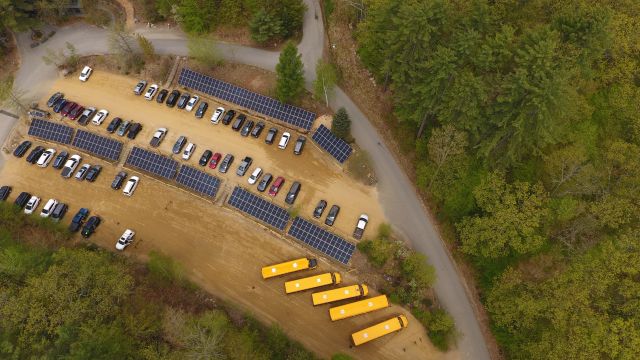 The 240 solar panels you see in our parking lot array, combined with the 68 panels mounted on the roof of our Blue Heron School are projected to offset a large percentage of the Science Center’s electric usage and save more than 80 tons of carbon emissions annually. Check out our interactive Solar Array Dashboard.
The 240 solar panels you see in our parking lot array, combined with the 68 panels mounted on the roof of our Blue Heron School are projected to offset a large percentage of the Science Center’s electric usage and save more than 80 tons of carbon emissions annually. Check out our interactive Solar Array Dashboard. Welcome Center
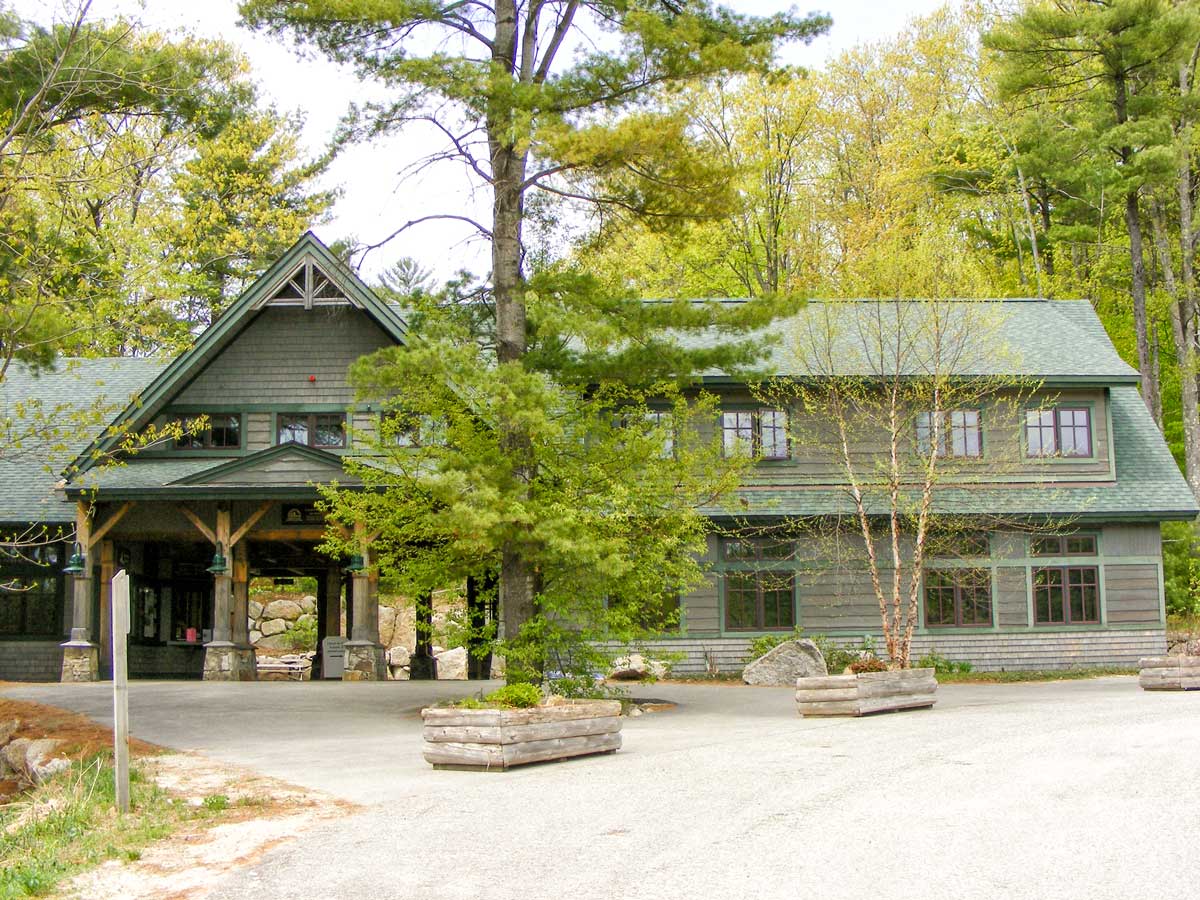 The Welcome Center is where you will check in for your trail entry time. Explore the outdoor Howling Coyote Gift Shop. The Welcome Center also houses administrative offices. Two EV charging stations are free for use by Science Center visitors only during regular operating hours. Gates close at 5:30 p.m.
The Welcome Center is where you will check in for your trail entry time. Explore the outdoor Howling Coyote Gift Shop. The Welcome Center also houses administrative offices. Two EV charging stations are free for use by Science Center visitors only during regular operating hours. Gates close at 5:30 p.m.Wood Energy Exhibit
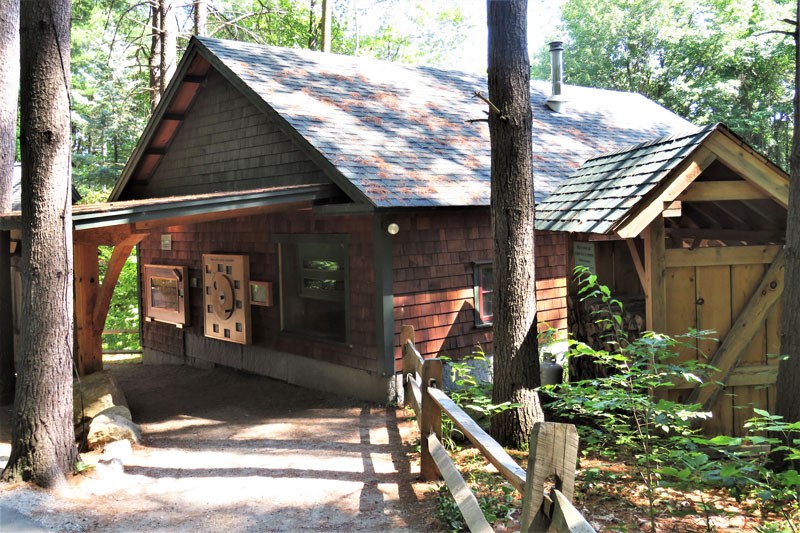 A model of sustainability: saving energy and dollars. The Wood Energy Exhibit uses sustainably-harvested, locally-sourced wood to heats five major buildings on the Science Center's campus.
A model of sustainability: saving energy and dollars. The Wood Energy Exhibit uses sustainably-harvested, locally-sourced wood to heats five major buildings on the Science Center's campus.Picnic Area
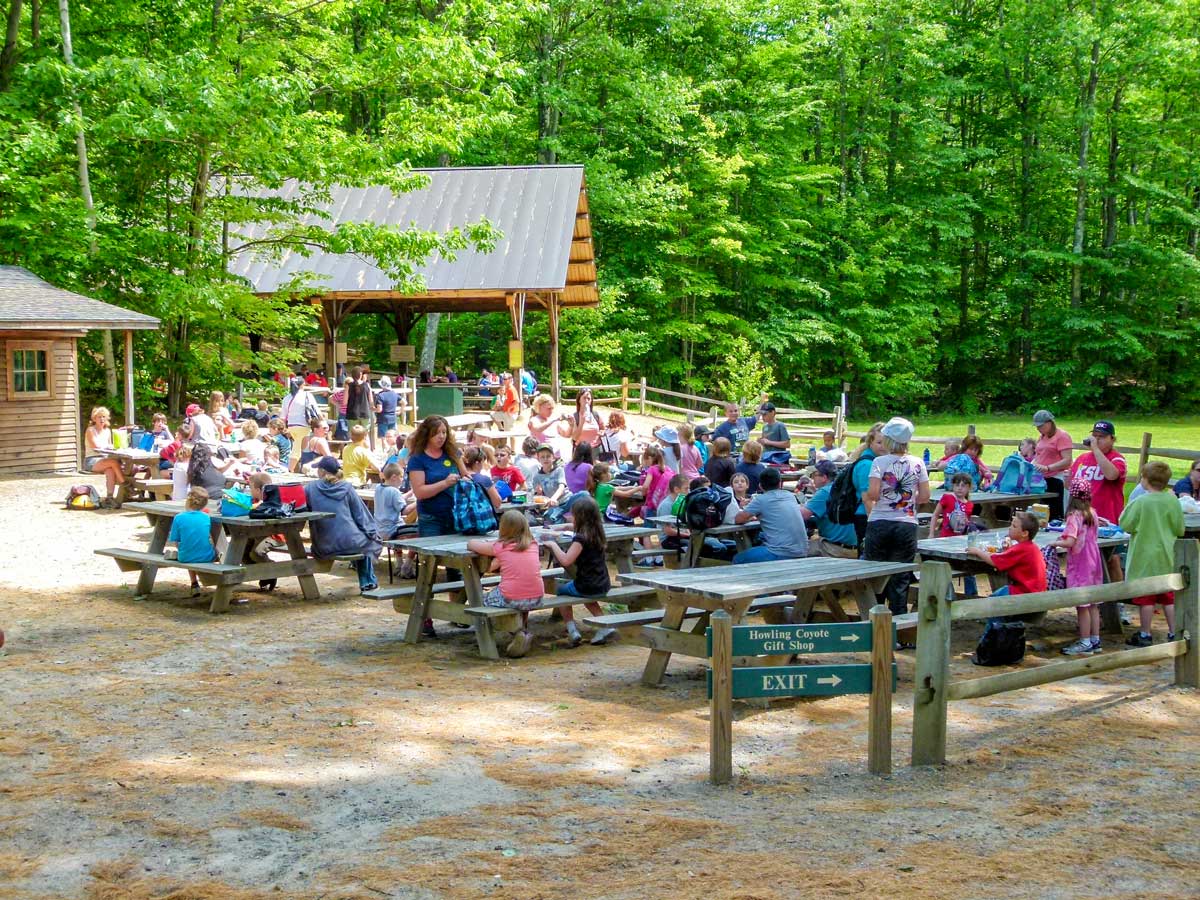 The Picnic Pavilion and Area is located at the start of the live animal exhibit trail. For the sake of our animals please keep food and drink (except for water) off the animal trail. The covered Picnic Pavilion will keep you dry on a rainy day. Limited seating is also available at Kirkwood Gardens.
The Picnic Pavilion and Area is located at the start of the live animal exhibit trail. For the sake of our animals please keep food and drink (except for water) off the animal trail. The covered Picnic Pavilion will keep you dry on a rainy day. Limited seating is also available at Kirkwood Gardens. Volunteer Headquarters
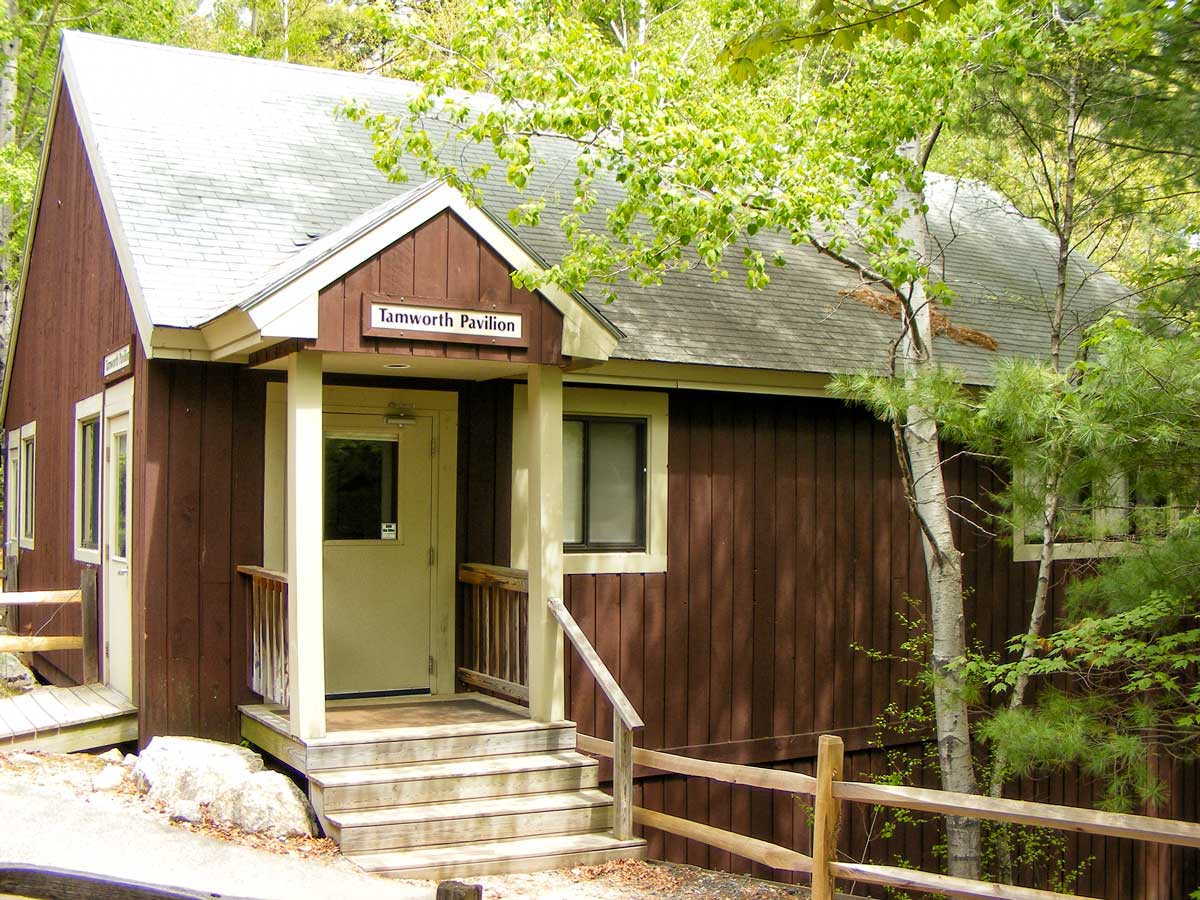 The Volunteer Headquarters is home to Volunteer Manager and our dedicated volunteers.
The Volunteer Headquarters is home to Volunteer Manager and our dedicated volunteers.Webster Education Building
Hidden Stories Exhibit
Learn More
Trailhead Event Space
Life Underground
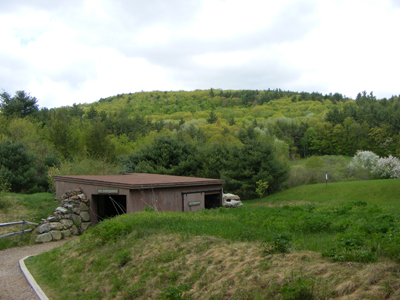 An amazing number of animals make their living in the soil. One handful of healthy topsoil may contain more living organisms than there are humans on Earth! You will meet ants and earthworms up close and peer at tiny soil animals through a microscope. You can also travel down a human-size chipmunk burrow. This exhibit addresses concepts such as how soil is formed, which organisms can help create and aerate soil, and what adaptations animals may have in order to survive underground.
An amazing number of animals make their living in the soil. One handful of healthy topsoil may contain more living organisms than there are humans on Earth! You will meet ants and earthworms up close and peer at tiny soil animals through a microscope. You can also travel down a human-size chipmunk burrow. This exhibit addresses concepts such as how soil is formed, which organisms can help create and aerate soil, and what adaptations animals may have in order to survive underground.
Amphitheater
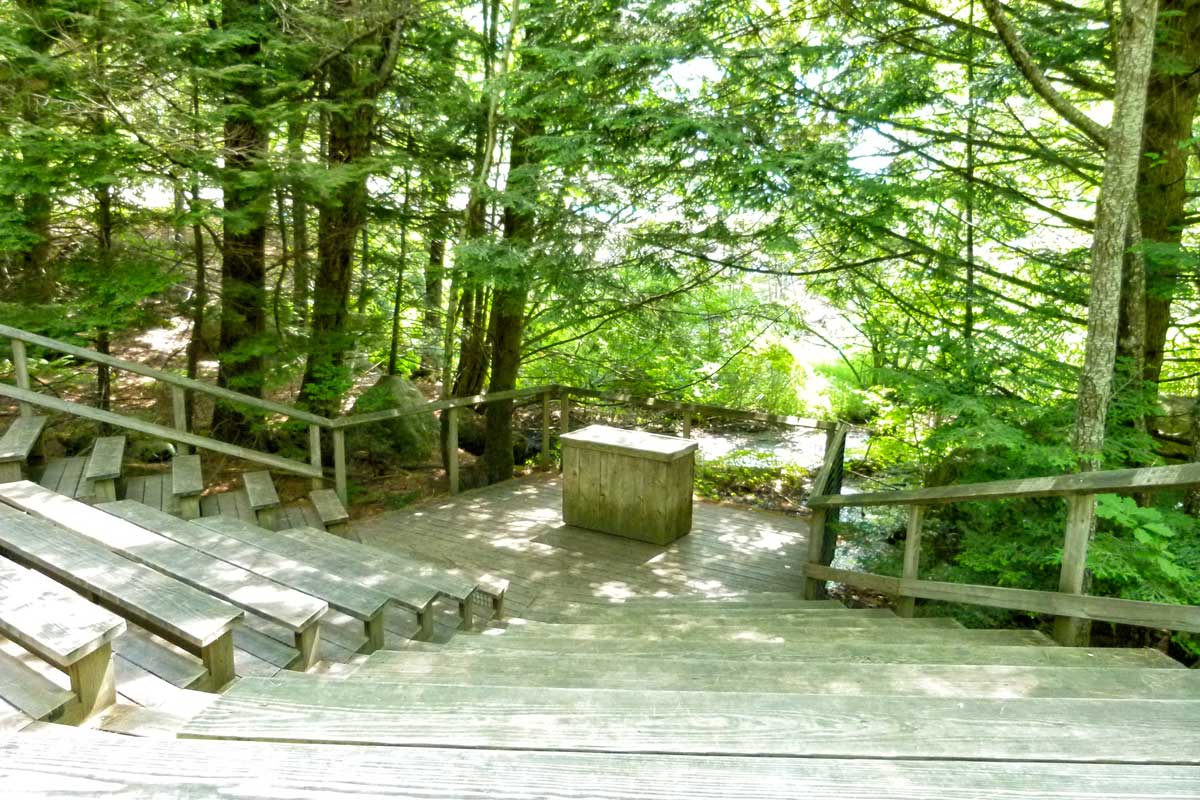 The Amphitheater comfortably located in the shade of the trees on the animal trail. Our daily Up Close to Animals presentations (July and August) are held here, weather depending. Naturalist led presentations feature a variety of animals including birds, mammals, and reptiles.
The Amphitheater comfortably located in the shade of the trees on the animal trail. Our daily Up Close to Animals presentations (July and August) are held here, weather depending. Naturalist led presentations feature a variety of animals including birds, mammals, and reptiles.
Water Matters Pavilion
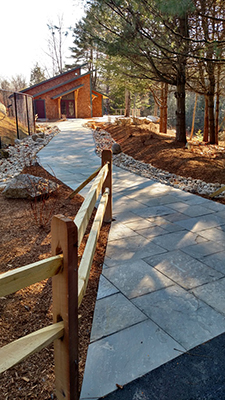 Explore the world of water through water-related exhibits and live animals. Listen to frog calls; take a virtual tour of the Squam Watershed; create an interactive landscape in kinetic sand to learn how water moves; learn about ice; visit the live turtles, and frogs; spy fish in the warm and cold water aquariums; plus much more!
Explore the world of water through water-related exhibits and live animals. Listen to frog calls; take a virtual tour of the Squam Watershed; create an interactive landscape in kinetic sand to learn how water moves; learn about ice; visit the live turtles, and frogs; spy fish in the warm and cold water aquariums; plus much more!
Coyote Exhibit
 Coyotes are cousins to dogs, wolves, and foxes, first seen in New Hampshire in 1944. They have spread across the state from the northernmost reaches down to the seacoast. Coyotes are currently common throughout the state. Try to match the coyote posture to the behavior and listen to a coyote call. Plus, learn how coyotes and wolves are similar and different. Learn about coyotes.
Coyotes are cousins to dogs, wolves, and foxes, first seen in New Hampshire in 1944. They have spread across the state from the northernmost reaches down to the seacoast. Coyotes are currently common throughout the state. Try to match the coyote posture to the behavior and listen to a coyote call. Plus, learn how coyotes and wolves are similar and different. Learn about coyotes.
Our coyote arrived in May 2013 at approximately 10 days old. She was found on the side of the road after the mother coyote was hit and killed by a car.
Ecotone Mammal Exhibit
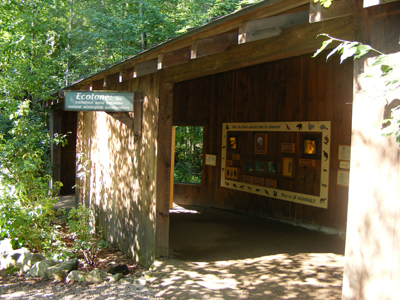 The Ecotone Mammal Exhibit reveals the interrelationships of creatures living in an "ecotone", or the edge between two natural communities. There is often greater diversity in wildlife at these edges. Using interactive displays, this exhibit describes these areas, provides examples of animals that depend on them, and also addresses some of their adaptations. This exhibit is the home to Red Foxes that are generally found living in an ecotone and Fisher which is a forest dweller: red fox and fisher.
The Ecotone Mammal Exhibit reveals the interrelationships of creatures living in an "ecotone", or the edge between two natural communities. There is often greater diversity in wildlife at these edges. Using interactive displays, this exhibit describes these areas, provides examples of animals that depend on them, and also addresses some of their adaptations. This exhibit is the home to Red Foxes that are generally found living in an ecotone and Fisher which is a forest dweller: red fox and fisher.
Bobcat Exhibit
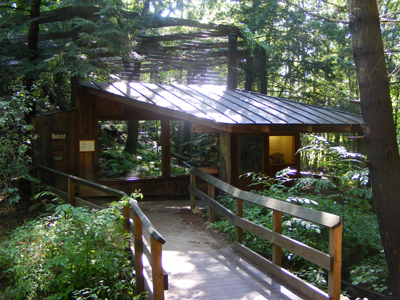 The bobcat gets its name from its short, or "bobbed" tail. An adult weighs 15 to 25 pounds and can live up to 14 years. Predators like bobcats help maintain healthy populations of prey animals by weeding out sick and injured animals. This in turn reduces the chance the prey animals will overeat and damage their habitat or starve. See live bobcats up close as you learn if bobcats have any predators and what they eat.
The bobcat gets its name from its short, or "bobbed" tail. An adult weighs 15 to 25 pounds and can live up to 14 years. Predators like bobcats help maintain healthy populations of prey animals by weeding out sick and injured animals. This in turn reduces the chance the prey animals will overeat and damage their habitat or starve. See live bobcats up close as you learn if bobcats have any predators and what they eat.
Our female bobcat arrived in 2011 at two years old after being confiscated while being kept as a pet. The male bobcat arrived in 2008 at two years old having been orphaned and illegally kept as a pet.
Mountain Lion Exhibit
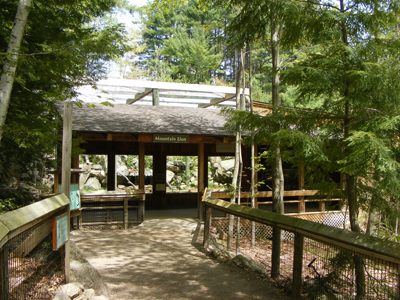 The mountain lion has one of the widest distributions of any mammal in the western hemisphere. They are able to survive a wide range of conditions and have the skills to hunt many different types of prey. This exhibit emphasizes the adaptations these animals have to hunt - how high and far they can jump or how much they can lift - and also addresses the ecological concept of extirpation. Large carnivores are rarely seen in New England since they need a lot of uninhabited space. An example of the interrelationships between animals and humans would be when early settlers, afraid for their safety and that of their livestock, over-hunted and eliminated mountain lions in New England.
The mountain lion has one of the widest distributions of any mammal in the western hemisphere. They are able to survive a wide range of conditions and have the skills to hunt many different types of prey. This exhibit emphasizes the adaptations these animals have to hunt - how high and far they can jump or how much they can lift - and also addresses the ecological concept of extirpation. Large carnivores are rarely seen in New England since they need a lot of uninhabited space. An example of the interrelationships between animals and humans would be when early settlers, afraid for their safety and that of their livestock, over-hunted and eliminated mountain lions in New England.
The two male mountain lions arrived at the Science Center in January 2023 from the state of Washington after being orphaned and surrendered to Washington Fish and Wildlife. Because mountain lion cubs stay with and rely on their mother for up to eighteen months, they could not be released back to the wild and Washington officials found suitable placements around the country for these and other orphaned cubs.
White-tailed Deer Exhibit
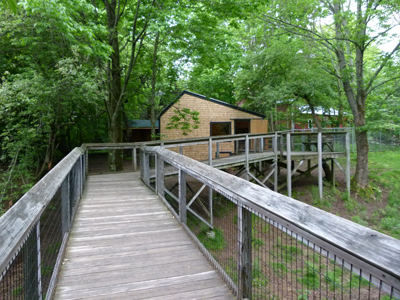 White-tailed deer are found throughout New Hampshire. This exhibit addresses many of the adaptations that enable deer to outwit their predators and survive, and also emphasizes some of the natural conditions that limit the population of deer in New Hampshire. Most natural predators (wolves and mountain lions) were extirpated in New Hampshire by the turn of the nineteenth. The only remaining predators of white-tailed deer in New Hampshire are humans and also occasionally domestic dogs, coyotes, and bobcats. Observe the live white-tailed deer in this exhibit and learn about their habitat through hands-on activities.
White-tailed deer are found throughout New Hampshire. This exhibit addresses many of the adaptations that enable deer to outwit their predators and survive, and also emphasizes some of the natural conditions that limit the population of deer in New Hampshire. Most natural predators (wolves and mountain lions) were extirpated in New Hampshire by the turn of the nineteenth. The only remaining predators of white-tailed deer in New Hampshire are humans and also occasionally domestic dogs, coyotes, and bobcats. Observe the live white-tailed deer in this exhibit and learn about their habitat through hands-on activities.
The female white-tailed deer was one year old when she arrived in 2018 after being found as a potential pet.
Red Barn
The Red Barn contains two bathrooms available for guest use.
Kirkwood Gardens
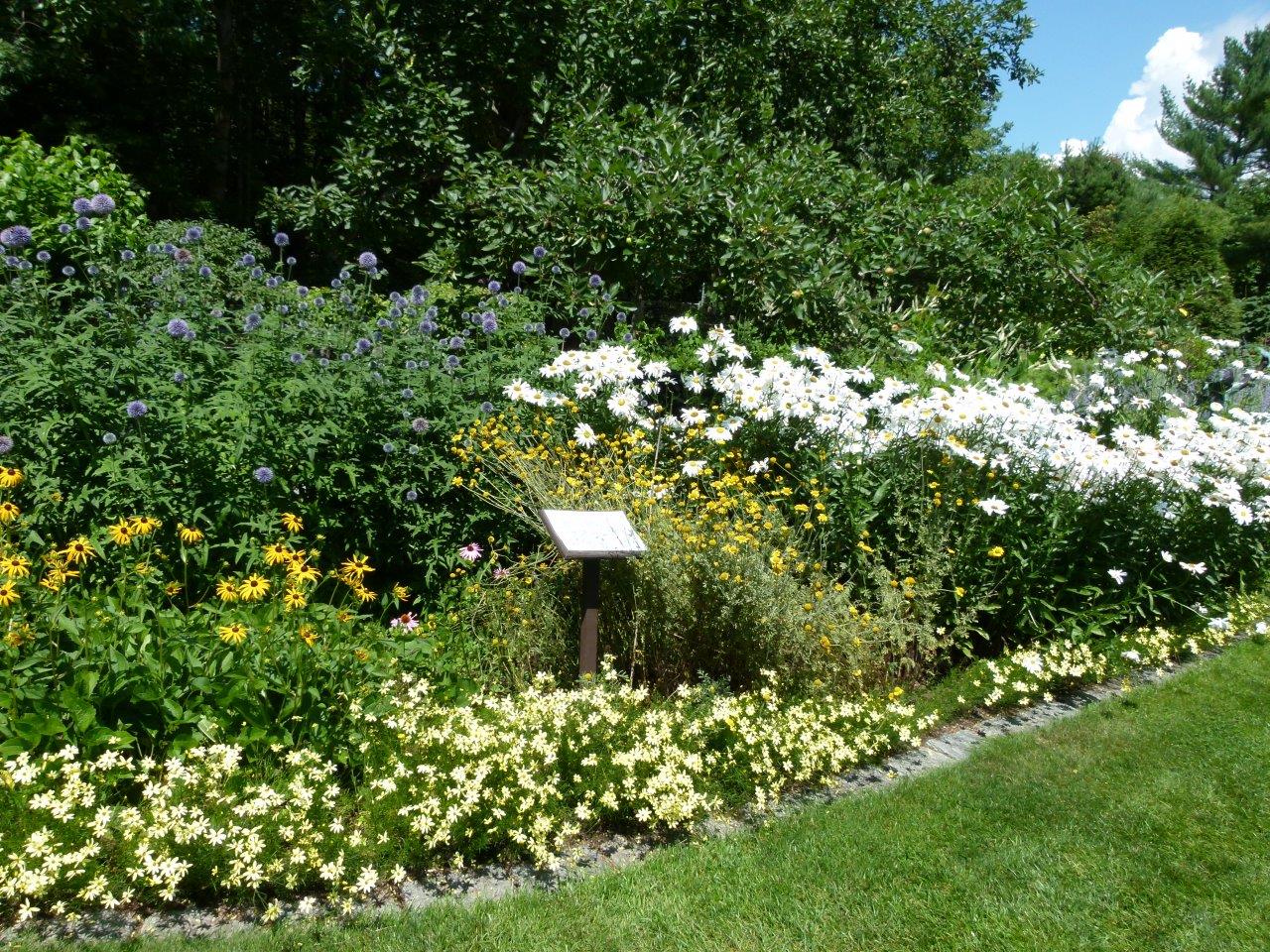 Colorful plants in full bloom bring this informal garden to life, naturally attracting bees, butterflies, and birds of many species. Kirkwood Gardens is free and open to the public but parking is limited.
Colorful plants in full bloom bring this informal garden to life, naturally attracting bees, butterflies, and birds of many species. Kirkwood Gardens is free and open to the public but parking is limited.
River Otter Exhibit
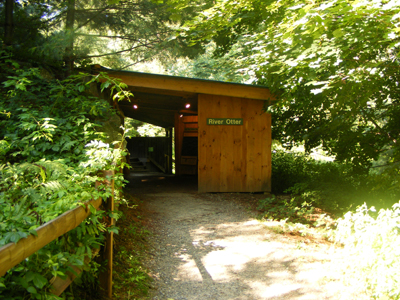 River otters have adaptations that allow them to live in marshes, swamps, rivers, ponds, and lakes. Otters are commonly found in New Hampshire. Their habitat requirements include unpolluted aquatic environments with unmanaged tree-lined shores. This exhibit emphasizes these requirements and also provides examples of aquatic adaptations and threats to otter populations. Watch live river otters swim with underwater viewing at this exhibit.
River otters have adaptations that allow them to live in marshes, swamps, rivers, ponds, and lakes. Otters are commonly found in New Hampshire. Their habitat requirements include unpolluted aquatic environments with unmanaged tree-lined shores. This exhibit emphasizes these requirements and also provides examples of aquatic adaptations and threats to otter populations. Watch live river otters swim with underwater viewing at this exhibit.
The male river otter was 18 months old when he arrived in 2012. He was abandoned after the Gulf oil spill in 2010 at two weeks old. He was taken to Southeast Wildlife Rescue in Louisiana and was habituated to humans due to the the necessary care. The female river otter arrived in 2022 from the Pueblo Zoo in Colorado.
Gordon Interactive Playscape: A Predator-Prey Adventure
 Go on an adventure as you play the role of a red squirrel. Climb rocks and logs, scramble through tunnels, and balance on branches to escape predators.
Go on an adventure as you play the role of a red squirrel. Climb rocks and logs, scramble through tunnels, and balance on branches to escape predators.
To better enjoy your visit, please follow the Playscape Guidelines:
- Adults must supervise children while they are on the Playscape.
- Children under 5 must be accompanied by an adult at all times.
- Children must have appropriate footwear. No flip-flops.
- To provide a safe and enjoyable environment for everyone, please:
- Walk, do not run
- Take turns
- Leave room to play safely
- Be kind
- Have fun
- Explore
- Discover and learn
Gordon Children's Center
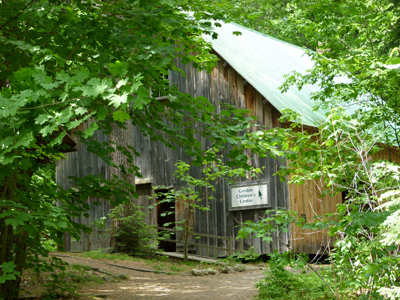 This two-story barn inspires students to learn more about natural concepts including adaptations, habitats, and interrelationships. Students learn as they use their eyes, ears, noses, hands, and brains while they climb through a giant spider web, invent an insect, crawl through an underground tunnel, listen to nocturnal animal sounds, and explore this activity-filled space.
This two-story barn inspires students to learn more about natural concepts including adaptations, habitats, and interrelationships. Students learn as they use their eyes, ears, noses, hands, and brains while they climb through a giant spider web, invent an insect, crawl through an underground tunnel, listen to nocturnal animal sounds, and explore this activity-filled space.
Black Bear Exhibit
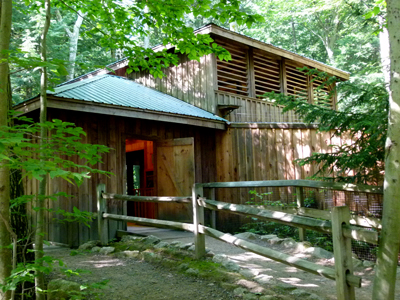 Black bears live in heavily wooded areas in New Hampshire. Although classified as carnivores, the majority of their diet consists of plant materials. Black bears have many interrelationships in the forest. This exhibit provides examples of some of these interrelationships and also provides details about their diet, behavior, and populations. You can learn about bears by completing puzzles, learning about bees with our viewable hive, and observing a live black bear in their habitat.
Black bears live in heavily wooded areas in New Hampshire. Although classified as carnivores, the majority of their diet consists of plant materials. Black bears have many interrelationships in the forest. This exhibit provides examples of some of these interrelationships and also provides details about their diet, behavior, and populations. You can learn about bears by completing puzzles, learning about bees with our viewable hive, and observing a live black bear in their habitat.
Our female black bear was two years old when she arrived at the Science Center in 2001. She was captive born in Illinois. The male black bear arrived at the Science Center in the fall of 2022 at approximately 9 months old. He was a rehabilitated bear from North Carolina who could not be released due to his habituation to people.
Celebrate Birds Exhibit
The Celebrate Birds Exhibit takes you on a journey to learn about types of birds. First learn about songbirds and water birds then enter the world of raptors. This exhibit features live New Hampshire species including Barred Owl, American Bittern, and Black-crowned Night-Heron.
The female Black-crowned Night Heron was an adult when she arrived in 2017. The exhibit she was in at the Virginia Aquarium was closed. The other Night Heron arrived at eight years old in 2019 as a transfer from another zoo.
Raptor Exhibit
Raptors are a group of birds that use adaptations such as grasping talons and a hooked beak to capture, kill, and tear their prey. The Raptor Exhibit features three buildings that house live New Hampshire species of raptors including Bald Eagle, Red-shouldered Hawk, Broad-winged Hawk, Red-tailed Hawk, Great Horned Owl, and American Kestrel.
Songbird Feeding Station
The Songbird Feeding Station offers a place to observe wild songbirds who visit the Science Center. Feeders are sanitized regularly to help stop the spread of Highly Pathogenic Avian Influenza (HPAI)
Upper Pond
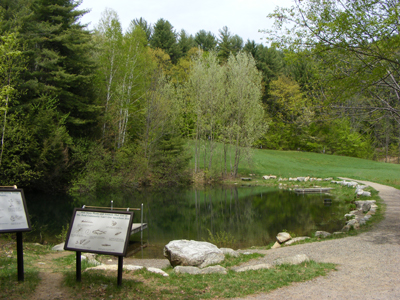 The Upper Pond provides examples of different types of wildlife that depend on wetlands and ponds. Some animals spend their entire life in water, like fish, while others rely on water for part of their life cycles, like toads. If you listen closely you can usually hear the croak of a frog or may even observe a heron, duck, or other water-loving bird at the Upper Pond.
The Upper Pond provides examples of different types of wildlife that depend on wetlands and ponds. Some animals spend their entire life in water, like fish, while others rely on water for part of their life cycles, like toads. If you listen closely you can usually hear the croak of a frog or may even observe a heron, duck, or other water-loving bird at the Upper Pond.
Wetlands Walk
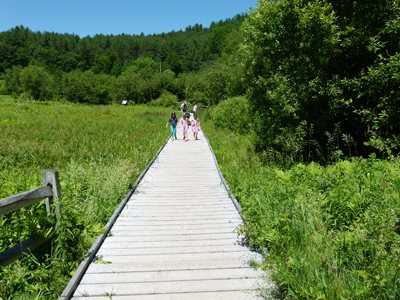 The Wetlands Walk takes you across a small man-made wetland, over an area of wet meadow, and across a small stream. Watch for frogs, salamanders, and turtles, as you learn the importance of wetlands along the way.
The Wetlands Walk takes you across a small man-made wetland, over an area of wet meadow, and across a small stream. Watch for frogs, salamanders, and turtles, as you learn the importance of wetlands along the way.
The Marsh Boardwalk was rebuilt in spring 2024 and you can sponsor a plaque with your own personalized message. Learn more.
View donor names from the previous boardwalk (2009).
Geology Exhibit
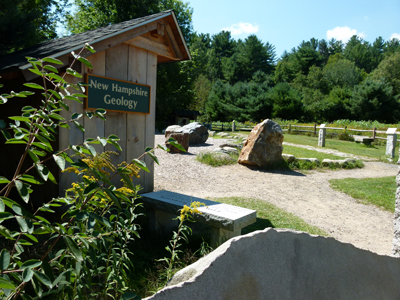 This exhibit highlights the geologic history of our planet and provides examples of the different types of rocks found in New Hampshire. Explore different rock types and take a walk through time to learn about the formation of our Earth.
This exhibit highlights the geologic history of our planet and provides examples of the different types of rocks found in New Hampshire. Explore different rock types and take a walk through time to learn about the formation of our Earth.
Lake Cruise Headquarters
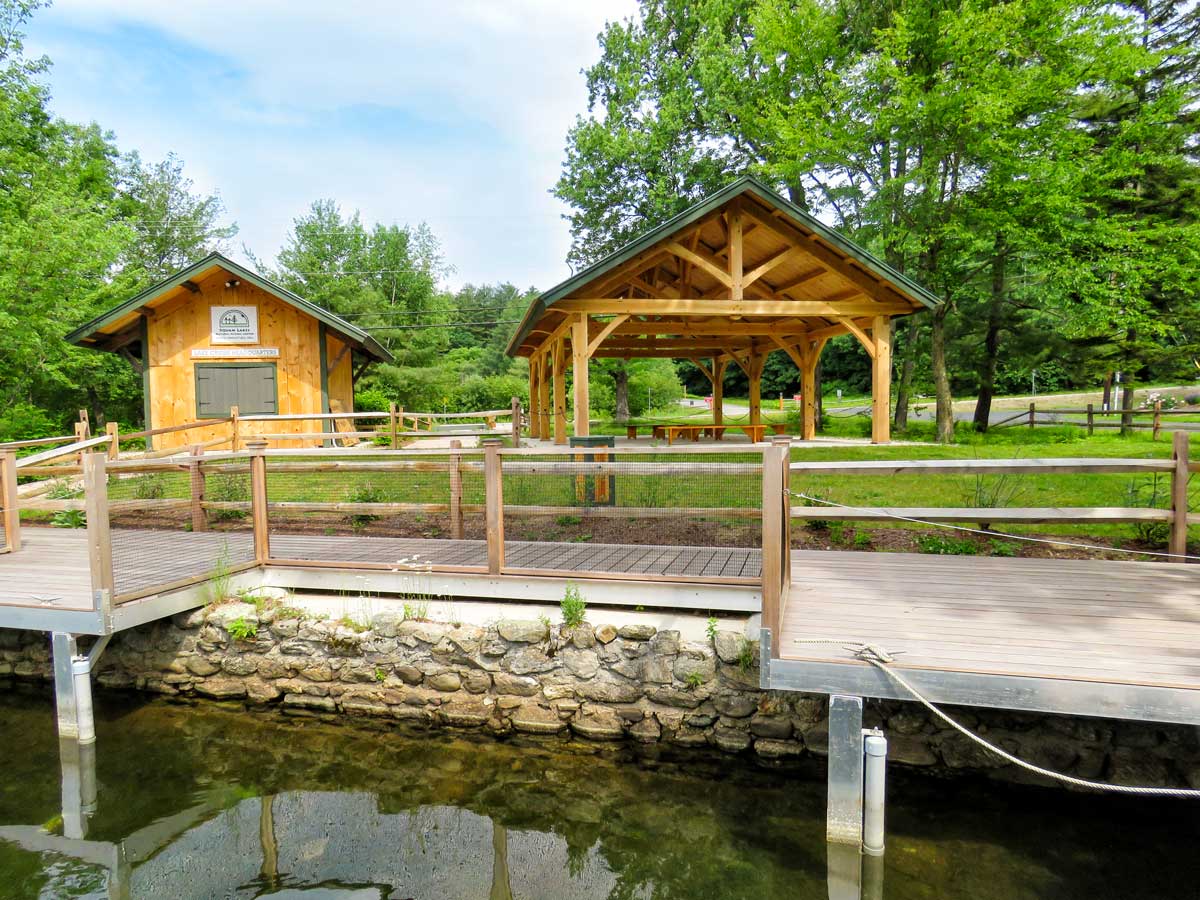 Solar powered Lake Cruise Headquarters provides a comfortable departure point for Squam Lake Cruises. The timber frame pavilion with benches provides an outdoor classroom for school programs and a place to gather before public cruises. Learn about solar electricity and lake turnover at interactive exhibits.
Solar powered Lake Cruise Headquarters provides a comfortable departure point for Squam Lake Cruises. The timber frame pavilion with benches provides an outdoor classroom for school programs and a place to gather before public cruises. Learn about solar electricity and lake turnover at interactive exhibits.
He treasured this corner of the earth and wondered of its mysteries.The Gephart Trail is informally and frequently called the live animal exhibit trail or live animal trail on this website and in other published pieces. The Gephart Trail is named in memory of William Stephen Gephart (1951-1968). His parents, F. Thomas Gephart and Sarah Lou Taylor Gephart, shared that love of earth's mysteries and helped others to know it through their support of the Science Center.
Squam Lakes Natural Science Center has educated and enlightened visitors since 1966 about the importance of our natural world thanks to the vision, energy, and generosity of people such as the Gephart family. Tom and Sally were involved in the early days and both served terms on the Board of Trustees, as later did their son John.


